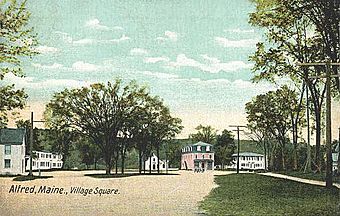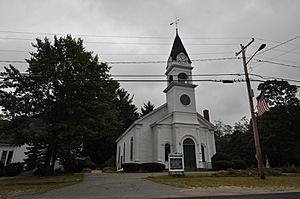Alfred Historic District facts for kids
Quick facts for kids |
|
|
Alfred Historic District
|
|

Village Square, Alfred, ME; from a 1906 postcard
|
|
| Location | Kennebunk, and Saco Roads. Alfred, Maine |
|---|---|
| Area | 15 acres (6.1 ha) |
| Architect | Multiple |
| Architectural style | Greek Revival, Federal |
| NRHP reference No. | 83000479 |
| Added to NRHP | April 28, 1983 |
The Alfred Historic District is a special area in Alfred, Maine, where many old and important buildings are protected. It's like a historical neighborhood! This district includes the old village center of Alfred. The area looks a bit like the letter "Y" and has many beautiful wooden buildings from the 1800s. This historic district was added to the National Register of Historic Places in 1983. This means it's officially recognized as a place with important history.
Exploring Alfred's History
Alfred was first settled by people in the 1760s. It officially became a town in 1794. Some of the oldest buildings in the village are from this time. Many of them have been changed over the years. These changes made them look more like buildings from the 1800s. For example, the "Barn Knight's Barn" house was built around 1770. Later, it got a new look with Italianate style details.
Becoming the County Seat
In the early 1800s, Alfred was chosen to be the county seat for York County, Maine. A county seat is the main town where the county government offices are located. This decision helped Alfred grow a lot! Many important lawyers chose to live here. They wanted to be close to the county courthouse.
One very famous lawyer was John Holmes. He moved to Alfred in 1794. He was very important in helping Alfred become the county seat. His house was built in 1802. It started as a smaller "Cape" style house. Later, in 1812, it was made taller with two full stories. People call it the "bow and arrow" house because of some special decorations. This house is also listed on the National Register of Historic Places by itself. It's famous because of its connection to John Holmes.
Buildings and Styles
Most of the buildings in Alfred Village were built in the early to mid-1800s. They show off the popular building styles of that time. You can see many Federal style houses. Some of these, like the Daniel Goodenow House from 1826, have also been updated over time.
The Alfred Parish Church was built in 1834. It's a great example of the Greek Revival style. This style often looks like ancient Greek temples. Many of the public buildings in the district are from the mid-1800s or later.
- The Town Hall was built in 1862 and has an Italianate style.
- The fire station is from around 1911. It has a Late Victorian look.
- The Old County Jail was built in 1871. A famous architect named Gridley James Fox Bryant designed it.
The York County Courthouse has parts that are very old. Some parts date back to its original building in 1807. Later, in 1856, new wings were added in the Italianate style. The courthouse was damaged by a fire in 1933. It was rebuilt and now looks like a Colonial Revival building. The main store in the village, the Alfred Country Store, is in a building from about 1841. It was originally Greek Revival but has also been changed over the years.
See Also




